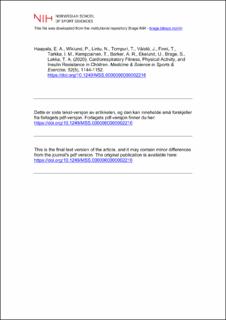| dc.contributor.author | Haapala, Eero A. | |
| dc.contributor.author | Wiklund, Petri | |
| dc.contributor.author | Lintu, Niina | |
| dc.contributor.author | Tompuri, Tuomo | |
| dc.contributor.author | Väistö, Juuso | |
| dc.contributor.author | Finni, Taija | |
| dc.contributor.author | Tarkka, Ina M. | |
| dc.contributor.author | Kemppainen, Titta | |
| dc.contributor.author | Barker, Alan R. | |
| dc.contributor.author | Ekelund, Ulf | |
| dc.contributor.author | Brage, Søren | |
| dc.contributor.author | Lakka, Timo A. | |
| dc.date.accessioned | 2021-06-07T07:31:29Z | |
| dc.date.available | 2021-06-07T07:31:29Z | |
| dc.date.created | 2021-01-06T15:50:44Z | |
| dc.date.issued | 2020 | |
| dc.identifier.citation | Medicine & Science in Sports & Exercise. 2020, 52(5), 1144-1152. | en_US |
| dc.identifier.issn | 0195-9131 | |
| dc.identifier.uri | https://hdl.handle.net/11250/2758073 | |
| dc.description | Dette er siste tekst-versjon av artikkelen, og den kan inneholde små forskjeller fra forlagets pdf-versjon. Forlagets pdf-versjon finner du her: https://doi.org/10.1249/MSS.0000000000002216 / This is the final text version of the article, and it may contain minor differences from the journal's pdf version. The original publication is available here: https://doi.org/10.1249/MSS.0000000000002216 | en_US |
| dc.description.abstract | Purpose: Few studies have investigated the independent and joint associations of cardiorespiratory fitness (CRF) and body fat percentage (BF%) with insulin resistance in children. We investigated the independent and combined associations of CRF and BF% with fasting glycemia and insulin resistance and their interactions with physical activity (PA) and sedentary time among 452 children age 6 to 8 yr. Methods: We assessed CRF with a maximal cycle ergometer exercise test and used allometrically scaled maximal power output (Wmax) for lean body mass (LM1.13) and body mass (BM1) as measures of CRF. The BF% and LM were measured by dual-energy X-ray absorptiometry, fasting glycemia by fasting plasma glucose, and insulin resistance by fasting serum insulin and Homeostatic Model Assessment for Insulin Resistance (HOMA-IR). The PA energy expenditure, moderate-to-vigorous PA (MVPA), and sedentary time were assessed by combined movement and heart rate sensor. Results: Wmax/LM1.13 was not associated with glucose (β = 0.065, 95% confidence interval [CI] = −0.031 to 0.161), insulin (β = −0.079, 95% CI = −0.172 to 0.015), or HOMA-IR (β = −0.065, 95% CI = −0.161 to 0.030). Wmax/BM1 was inversely associated with insulin (β = −0.289, 95% CI = −0.377 to −0.200) and HOMA-IR (β = −0.269, 95% CI = −0.359 to −0.180). The BF% was directly associated with insulin (β = 0.409, 95% CI = 0.325 to 0.494) and HOMA-IR (β = 0.390, 95% CI = 0.304 to 0.475). Higher Wmax/BM1, but not Wmax/LM1.13, was associated with lower insulin and HOMA-IR in children with higher BF%. Children with higher BF% and who had lower levels of MVPA or higher levels of sedentary time had the highest insulin and HOMA-IR. Conclusions: Children with higher BF% together with less MVPA or higher levels of sedentary time had the highest insulin and HOMA-IR. Cardiorespiratory fitness appropriately controlled for body size and composition using LM was not related to insulin resistance among children. | en_US |
| dc.language.iso | eng | en_US |
| dc.subject | diabetes | en_US |
| dc.subject | youth | en_US |
| dc.subject | exercise | en_US |
| dc.subject | performance | en_US |
| dc.subject | insulin | en_US |
| dc.subject | insulin sensitivity | en_US |
| dc.subject | obesity | en_US |
| dc.title | Cardiorespiratory Fitness, Physical Activity, and Insulin Resistance in Children | en_US |
| dc.type | Peer reviewed | en_US |
| dc.type | Journal article | en_US |
| dc.description.version | acceptedVersion | en_US |
| dc.source.pagenumber | 1144-1152 | en_US |
| dc.source.volume | 52 | en_US |
| dc.source.journal | Medicine & Science in Sports & Exercise | en_US |
| dc.source.issue | 5 | en_US |
| dc.identifier.doi | 10.1249/MSS.0000000000002216 | |
| dc.identifier.cristin | 1866532 | |
| dc.description.localcode | Institutt for idrettsmedisinske fag / Department of Sports Medicine | en_US |
| cristin.ispublished | true | |
| cristin.fulltext | postprint | |
| cristin.qualitycode | 2 | |
